Fundamentals of Operating Systems and Programming Report
VerifiedAdded on 2020/10/22
|6
|1111
|292
Report
AI Summary
This report provides a comprehensive overview of the role of operating systems (OS) as resource managers and extended machines across various devices, including clients, servers, and mobile devices. It details how OS allocate resources such as memory, processors, and input-output devices, ensuring efficient and controlled execution of commands while preventing resource conflicts. The report further explores the functions of OS in file sharing, graphical interfaces, and hardware/software usage, emphasizing their crucial role in client-server-mobile device interactions. Additionally, the report examines specific examples of operating systems, including Windows, Linux, and Android, highlighting their unique features, security measures, and resource management techniques. Windows OS is discussed for its security features, resource sharing protocols, and file/processor management methods. Linux OS is explored for its strong encryption and virtual memory management. Android OS is analyzed for its data abstraction, resource scheduling, and memory management techniques tailored for mobile devices. The report concludes by referencing relevant academic sources that support the information presented.
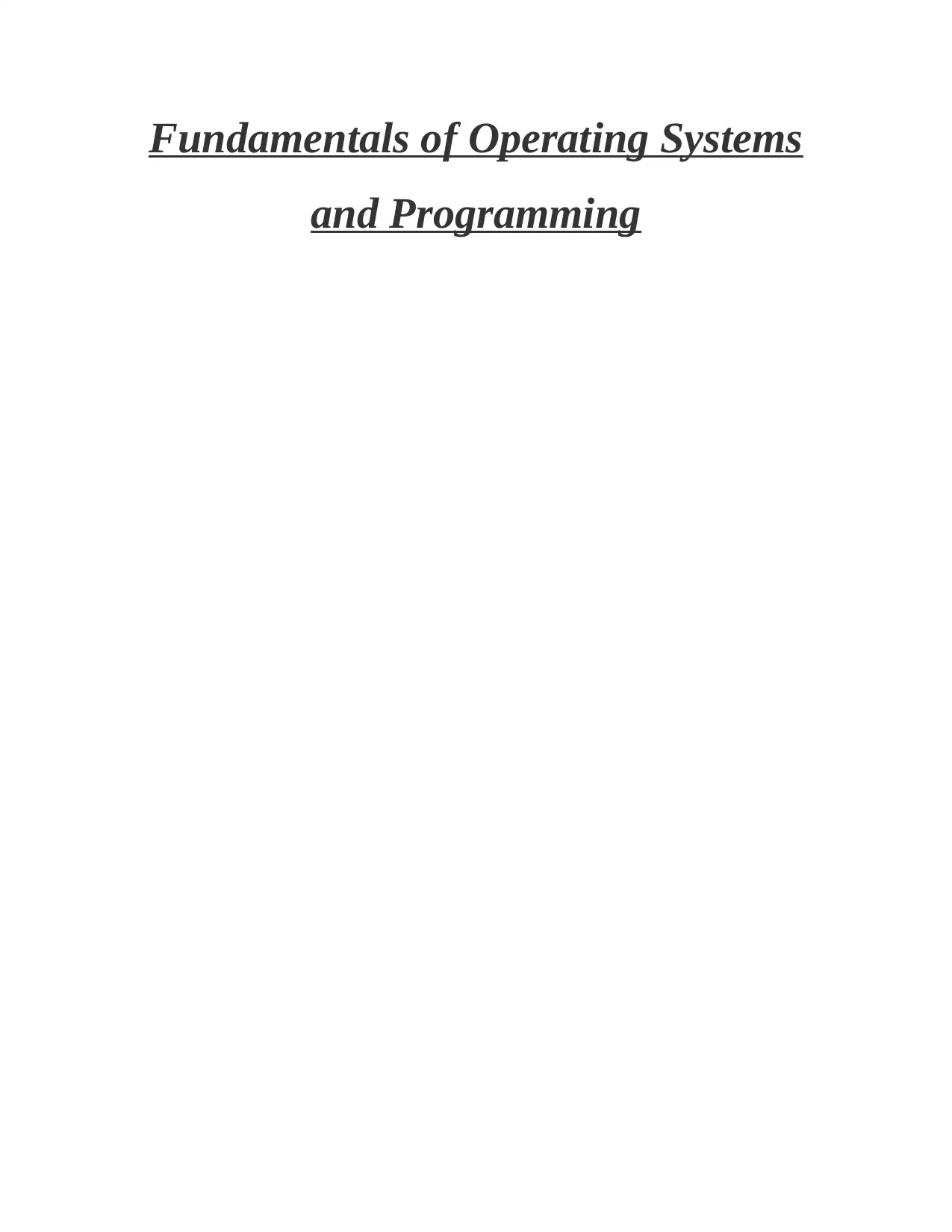
Fundamentals of Operating Systems
and Programming
and Programming
Paraphrase This Document
Need a fresh take? Get an instant paraphrase of this document with our AI Paraphraser
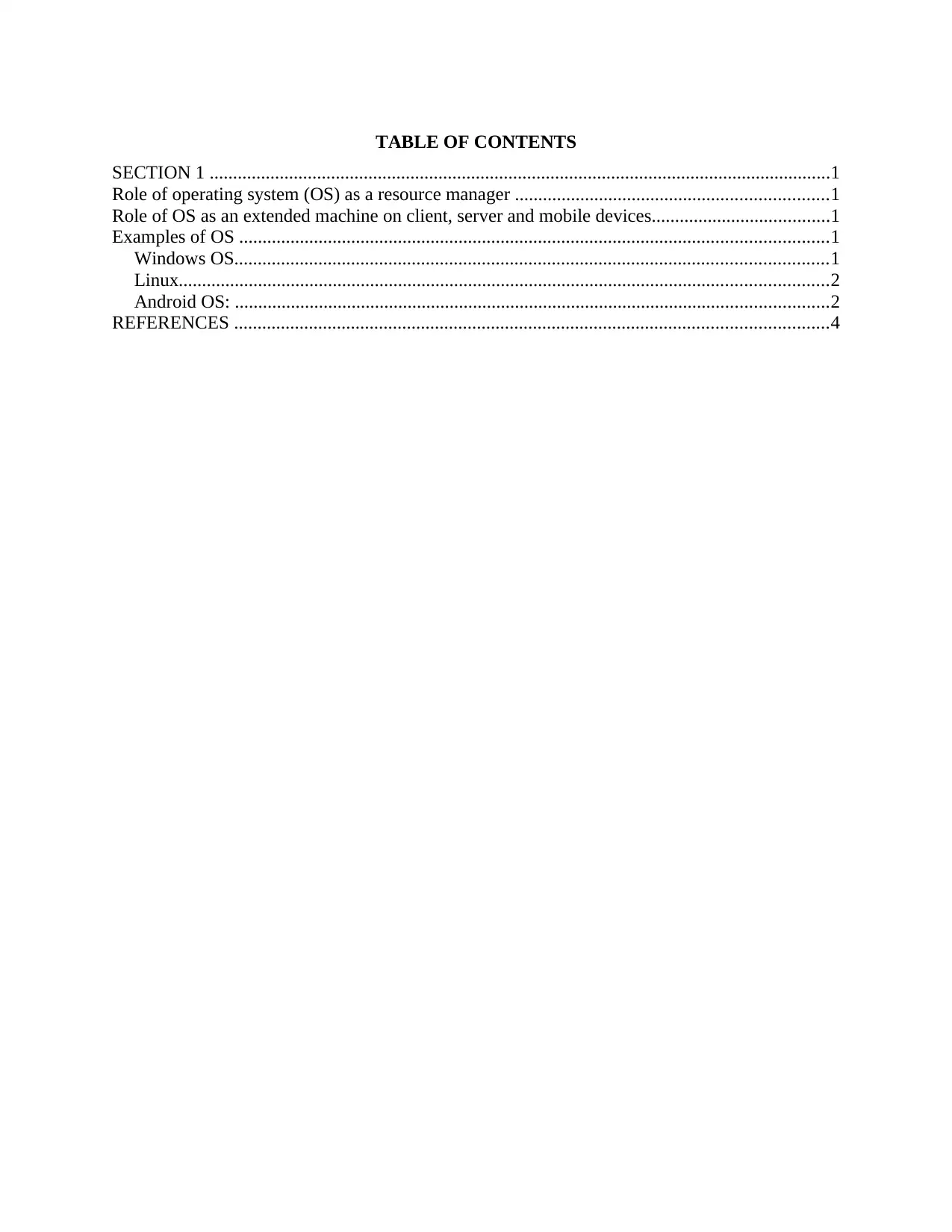
TABLE OF CONTENTS
SECTION 1 .....................................................................................................................................1
Role of operating system (OS) as a resource manager ...................................................................1
Role of OS as an extended machine on client, server and mobile devices......................................1
Examples of OS ..............................................................................................................................1
Windows OS...............................................................................................................................1
Linux...........................................................................................................................................2
Android OS: ...............................................................................................................................2
REFERENCES ...............................................................................................................................4
SECTION 1 .....................................................................................................................................1
Role of operating system (OS) as a resource manager ...................................................................1
Role of OS as an extended machine on client, server and mobile devices......................................1
Examples of OS ..............................................................................................................................1
Windows OS...............................................................................................................................1
Linux...........................................................................................................................................2
Android OS: ...............................................................................................................................2
REFERENCES ...............................................................................................................................4
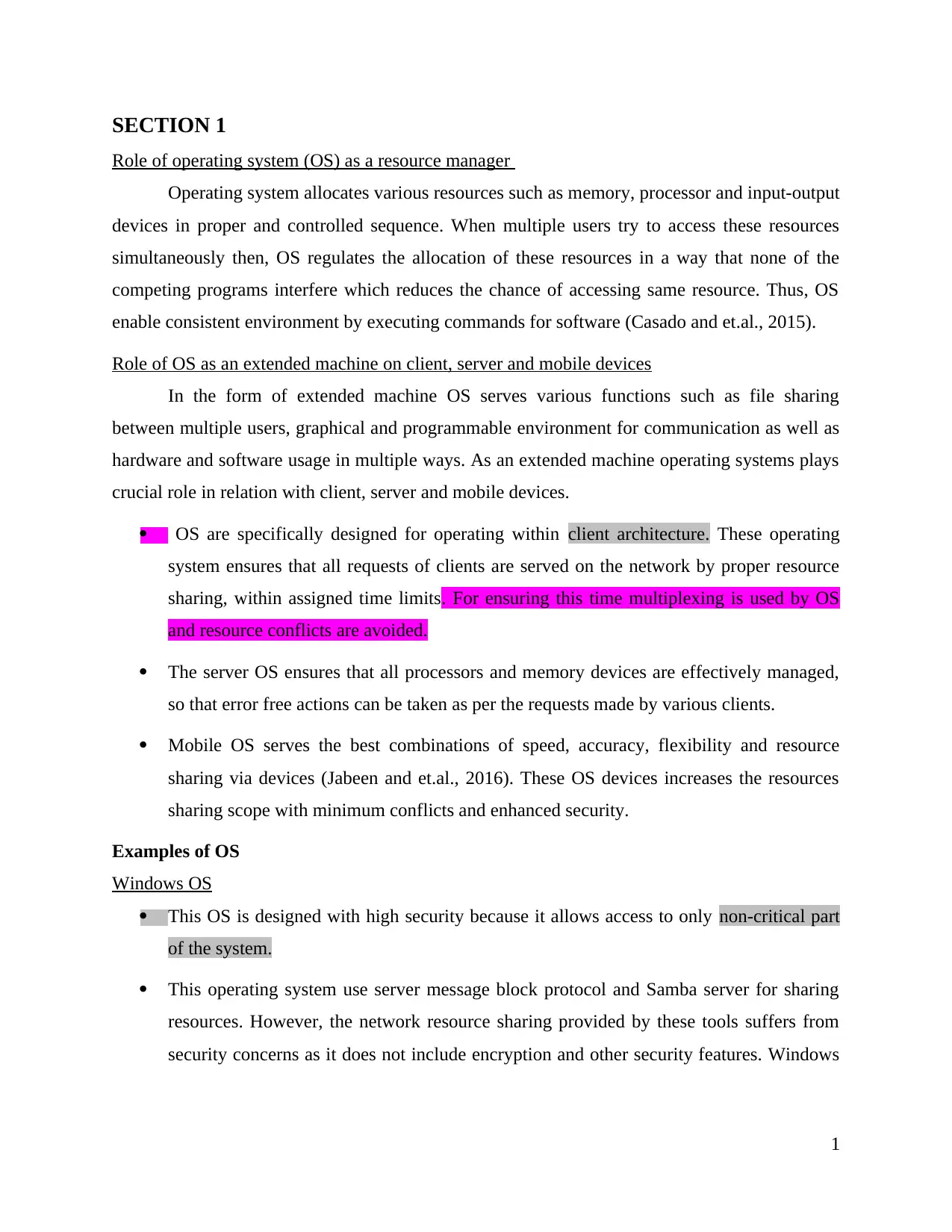
SECTION 1
Role of operating system (OS) as a resource manager
Operating system allocates various resources such as memory, processor and input-output
devices in proper and controlled sequence. When multiple users try to access these resources
simultaneously then, OS regulates the allocation of these resources in a way that none of the
competing programs interfere which reduces the chance of accessing same resource. Thus, OS
enable consistent environment by executing commands for software (Casado and et.al., 2015).
Role of OS as an extended machine on client, server and mobile devices
In the form of extended machine OS serves various functions such as file sharing
between multiple users, graphical and programmable environment for communication as well as
hardware and software usage in multiple ways. As an extended machine operating systems plays
crucial role in relation with client, server and mobile devices.
OS are specifically designed for operating within client architecture. These operating
system ensures that all requests of clients are served on the network by proper resource
sharing, within assigned time limits. For ensuring this time multiplexing is used by OS
and resource conflicts are avoided.
The server OS ensures that all processors and memory devices are effectively managed,
so that error free actions can be taken as per the requests made by various clients.
Mobile OS serves the best combinations of speed, accuracy, flexibility and resource
sharing via devices (Jabeen and et.al., 2016). These OS devices increases the resources
sharing scope with minimum conflicts and enhanced security.
Examples of OS
Windows OS
This OS is designed with high security because it allows access to only non-critical part
of the system.
This operating system use server message block protocol and Samba server for sharing
resources. However, the network resource sharing provided by these tools suffers from
security concerns as it does not include encryption and other security features. Windows
1
Role of operating system (OS) as a resource manager
Operating system allocates various resources such as memory, processor and input-output
devices in proper and controlled sequence. When multiple users try to access these resources
simultaneously then, OS regulates the allocation of these resources in a way that none of the
competing programs interfere which reduces the chance of accessing same resource. Thus, OS
enable consistent environment by executing commands for software (Casado and et.al., 2015).
Role of OS as an extended machine on client, server and mobile devices
In the form of extended machine OS serves various functions such as file sharing
between multiple users, graphical and programmable environment for communication as well as
hardware and software usage in multiple ways. As an extended machine operating systems plays
crucial role in relation with client, server and mobile devices.
OS are specifically designed for operating within client architecture. These operating
system ensures that all requests of clients are served on the network by proper resource
sharing, within assigned time limits. For ensuring this time multiplexing is used by OS
and resource conflicts are avoided.
The server OS ensures that all processors and memory devices are effectively managed,
so that error free actions can be taken as per the requests made by various clients.
Mobile OS serves the best combinations of speed, accuracy, flexibility and resource
sharing via devices (Jabeen and et.al., 2016). These OS devices increases the resources
sharing scope with minimum conflicts and enhanced security.
Examples of OS
Windows OS
This OS is designed with high security because it allows access to only non-critical part
of the system.
This operating system use server message block protocol and Samba server for sharing
resources. However, the network resource sharing provided by these tools suffers from
security concerns as it does not include encryption and other security features. Windows
1
⊘ This is a preview!⊘
Do you want full access?
Subscribe today to unlock all pages.

Trusted by 1+ million students worldwide
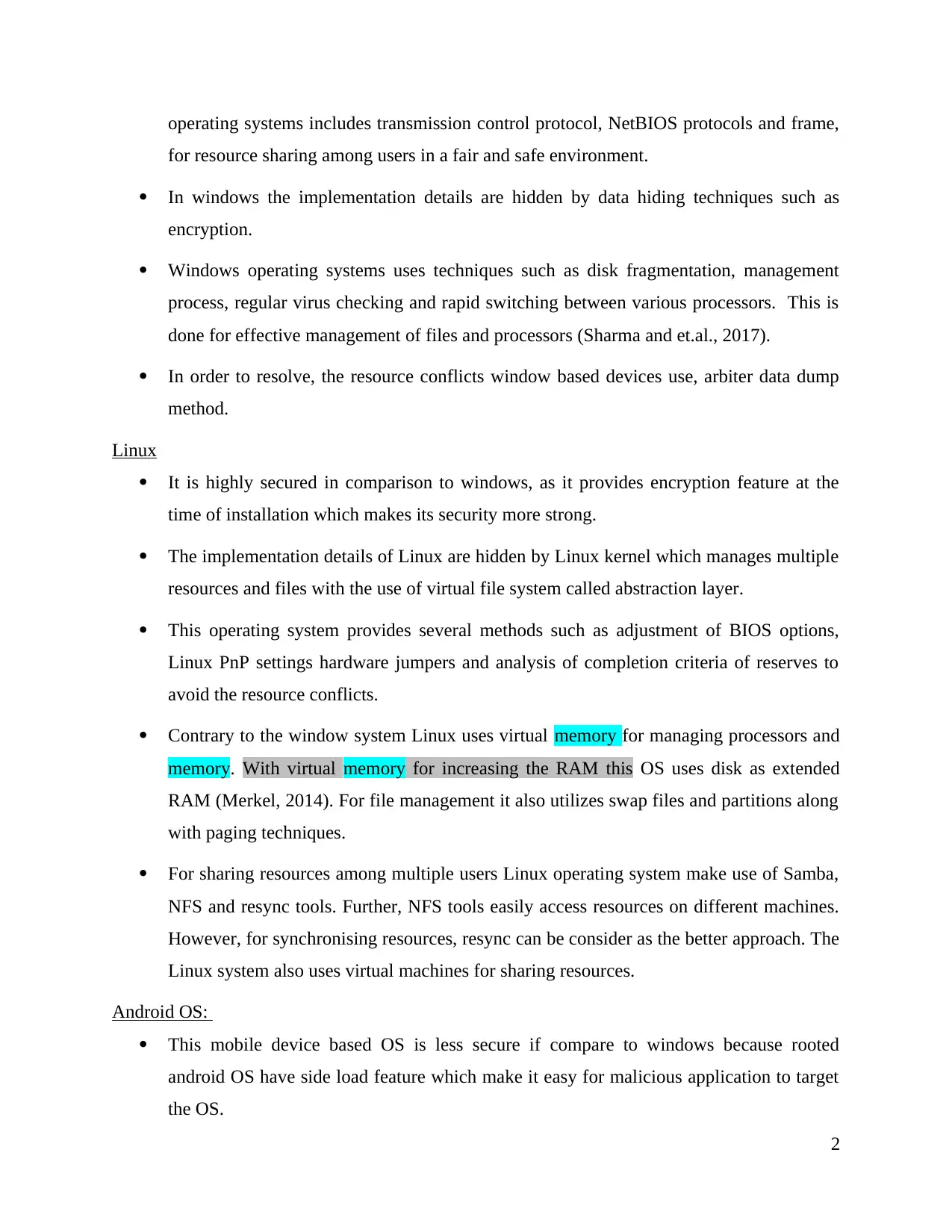
operating systems includes transmission control protocol, NetBIOS protocols and frame,
for resource sharing among users in a fair and safe environment.
In windows the implementation details are hidden by data hiding techniques such as
encryption.
Windows operating systems uses techniques such as disk fragmentation, management
process, regular virus checking and rapid switching between various processors. This is
done for effective management of files and processors (Sharma and et.al., 2017).
In order to resolve, the resource conflicts window based devices use, arbiter data dump
method.
Linux
It is highly secured in comparison to windows, as it provides encryption feature at the
time of installation which makes its security more strong.
The implementation details of Linux are hidden by Linux kernel which manages multiple
resources and files with the use of virtual file system called abstraction layer.
This operating system provides several methods such as adjustment of BIOS options,
Linux PnP settings hardware jumpers and analysis of completion criteria of reserves to
avoid the resource conflicts.
Contrary to the window system Linux uses virtual memory for managing processors and
memory. With virtual memory for increasing the RAM this OS uses disk as extended
RAM (Merkel, 2014). For file management it also utilizes swap files and partitions along
with paging techniques.
For sharing resources among multiple users Linux operating system make use of Samba,
NFS and resync tools. Further, NFS tools easily access resources on different machines.
However, for synchronising resources, resync can be consider as the better approach. The
Linux system also uses virtual machines for sharing resources.
Android OS:
This mobile device based OS is less secure if compare to windows because rooted
android OS have side load feature which make it easy for malicious application to target
the OS.
2
for resource sharing among users in a fair and safe environment.
In windows the implementation details are hidden by data hiding techniques such as
encryption.
Windows operating systems uses techniques such as disk fragmentation, management
process, regular virus checking and rapid switching between various processors. This is
done for effective management of files and processors (Sharma and et.al., 2017).
In order to resolve, the resource conflicts window based devices use, arbiter data dump
method.
Linux
It is highly secured in comparison to windows, as it provides encryption feature at the
time of installation which makes its security more strong.
The implementation details of Linux are hidden by Linux kernel which manages multiple
resources and files with the use of virtual file system called abstraction layer.
This operating system provides several methods such as adjustment of BIOS options,
Linux PnP settings hardware jumpers and analysis of completion criteria of reserves to
avoid the resource conflicts.
Contrary to the window system Linux uses virtual memory for managing processors and
memory. With virtual memory for increasing the RAM this OS uses disk as extended
RAM (Merkel, 2014). For file management it also utilizes swap files and partitions along
with paging techniques.
For sharing resources among multiple users Linux operating system make use of Samba,
NFS and resync tools. Further, NFS tools easily access resources on different machines.
However, for synchronising resources, resync can be consider as the better approach. The
Linux system also uses virtual machines for sharing resources.
Android OS:
This mobile device based OS is less secure if compare to windows because rooted
android OS have side load feature which make it easy for malicious application to target
the OS.
2
Paraphrase This Document
Need a fresh take? Get an instant paraphrase of this document with our AI Paraphraser
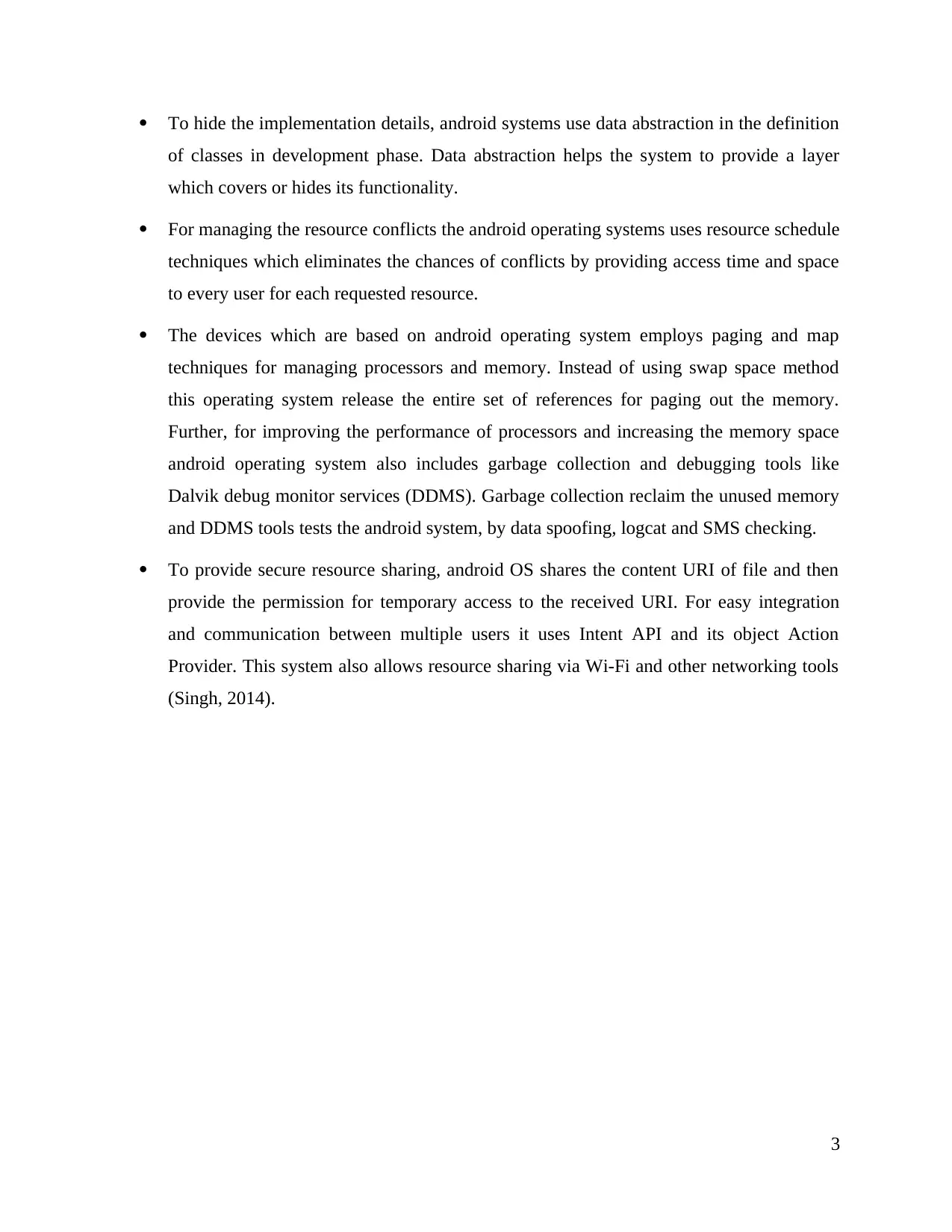
To hide the implementation details, android systems use data abstraction in the definition
of classes in development phase. Data abstraction helps the system to provide a layer
which covers or hides its functionality.
For managing the resource conflicts the android operating systems uses resource schedule
techniques which eliminates the chances of conflicts by providing access time and space
to every user for each requested resource.
The devices which are based on android operating system employs paging and map
techniques for managing processors and memory. Instead of using swap space method
this operating system release the entire set of references for paging out the memory.
Further, for improving the performance of processors and increasing the memory space
android operating system also includes garbage collection and debugging tools like
Dalvik debug monitor services (DDMS). Garbage collection reclaim the unused memory
and DDMS tools tests the android system, by data spoofing, logcat and SMS checking.
To provide secure resource sharing, android OS shares the content URI of file and then
provide the permission for temporary access to the received URI. For easy integration
and communication between multiple users it uses Intent API and its object Action
Provider. This system also allows resource sharing via Wi-Fi and other networking tools
(Singh, 2014).
3
of classes in development phase. Data abstraction helps the system to provide a layer
which covers or hides its functionality.
For managing the resource conflicts the android operating systems uses resource schedule
techniques which eliminates the chances of conflicts by providing access time and space
to every user for each requested resource.
The devices which are based on android operating system employs paging and map
techniques for managing processors and memory. Instead of using swap space method
this operating system release the entire set of references for paging out the memory.
Further, for improving the performance of processors and increasing the memory space
android operating system also includes garbage collection and debugging tools like
Dalvik debug monitor services (DDMS). Garbage collection reclaim the unused memory
and DDMS tools tests the android system, by data spoofing, logcat and SMS checking.
To provide secure resource sharing, android OS shares the content URI of file and then
provide the permission for temporary access to the received URI. For easy integration
and communication between multiple users it uses Intent API and its object Action
Provider. This system also allows resource sharing via Wi-Fi and other networking tools
(Singh, 2014).
3
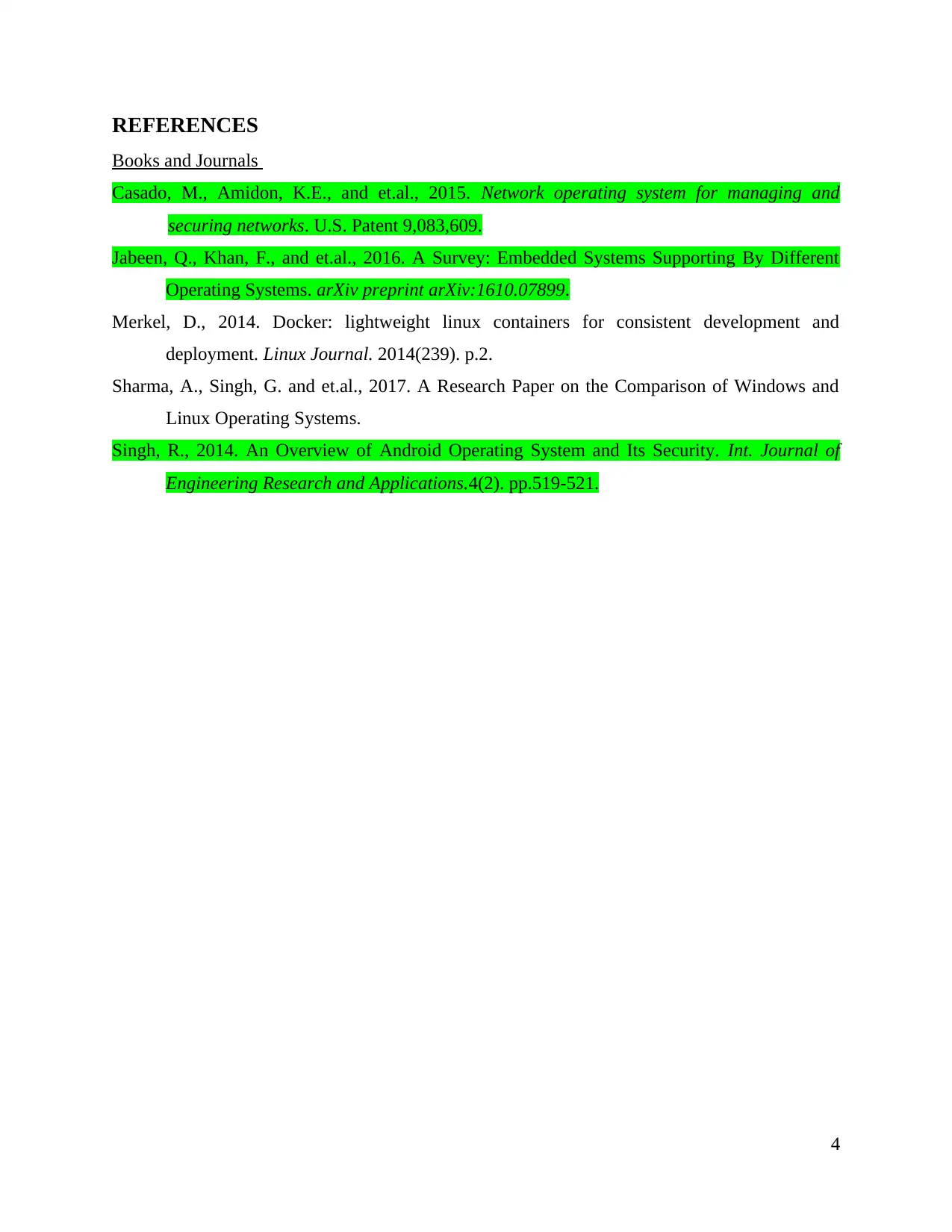
REFERENCES
Books and Journals
Casado, M., Amidon, K.E., and et.al., 2015. Network operating system for managing and
securing networks. U.S. Patent 9,083,609.
Jabeen, Q., Khan, F., and et.al., 2016. A Survey: Embedded Systems Supporting By Different
Operating Systems. arXiv preprint arXiv:1610.07899.
Merkel, D., 2014. Docker: lightweight linux containers for consistent development and
deployment. Linux Journal. 2014(239). p.2.
Sharma, A., Singh, G. and et.al., 2017. A Research Paper on the Comparison of Windows and
Linux Operating Systems.
Singh, R., 2014. An Overview of Android Operating System and Its Security. Int. Journal of
Engineering Research and Applications.4(2). pp.519-521.
4
Books and Journals
Casado, M., Amidon, K.E., and et.al., 2015. Network operating system for managing and
securing networks. U.S. Patent 9,083,609.
Jabeen, Q., Khan, F., and et.al., 2016. A Survey: Embedded Systems Supporting By Different
Operating Systems. arXiv preprint arXiv:1610.07899.
Merkel, D., 2014. Docker: lightweight linux containers for consistent development and
deployment. Linux Journal. 2014(239). p.2.
Sharma, A., Singh, G. and et.al., 2017. A Research Paper on the Comparison of Windows and
Linux Operating Systems.
Singh, R., 2014. An Overview of Android Operating System and Its Security. Int. Journal of
Engineering Research and Applications.4(2). pp.519-521.
4
⊘ This is a preview!⊘
Do you want full access?
Subscribe today to unlock all pages.

Trusted by 1+ million students worldwide
1 out of 6
Related Documents
Your All-in-One AI-Powered Toolkit for Academic Success.
+13062052269
info@desklib.com
Available 24*7 on WhatsApp / Email
![[object Object]](/_next/static/media/star-bottom.7253800d.svg)
Unlock your academic potential
Copyright © 2020–2025 A2Z Services. All Rights Reserved. Developed and managed by ZUCOL.




